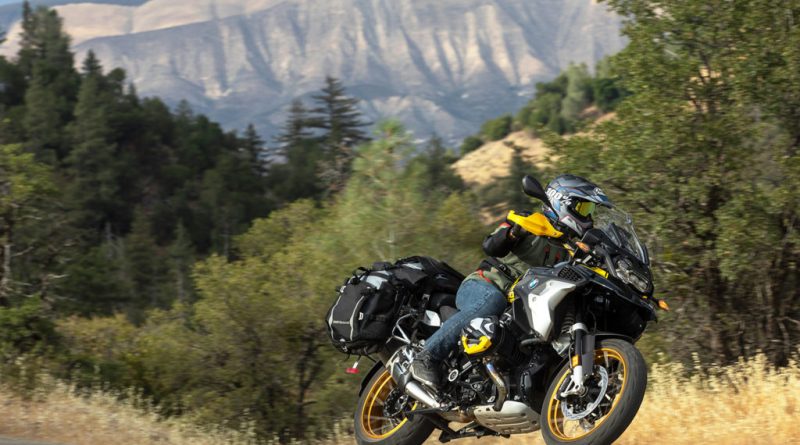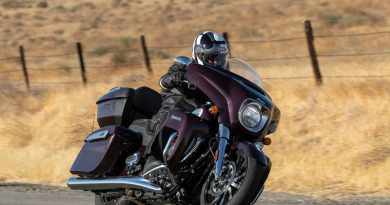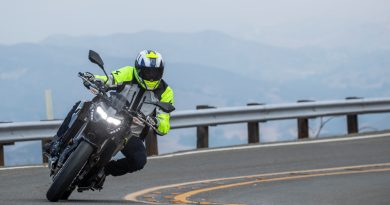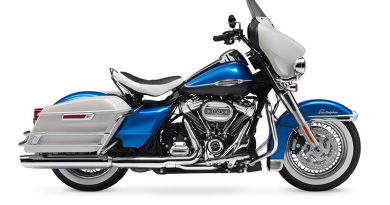2021 BMW R 1250 GS | Road Test Review
For four decades, the BMW R-GS series — 80, 100, 1000, 1100, 1150, 1200, and 1250 — has been the standard bearer in the adventure bike market. The 2021 R 1250 GS 40 Years Edition celebrates this milestone. (Photos by Kevin Wing)
When I first laid eyes on our 2021 BMW R 1250 GS 40 Years of GS Edition test bike, I thought of my Uncle Clive. He had worked for the doomed British Leyland for years before accepting a role with BMW. His garage, once the perpetual home to a gleaming Rover, was now occupied by a stunning 5 Series sedan, but it was the new motorcycle, waiting in the shadows, which drew my attention. It was unlike any I had seen before.
The air-cooled cylinder heads of its opposed Twin jutted out brazenly from the sides of the engine cases, protected by crash bars. Though it wasn’t a dirtbike, it shared some of the same characteristics, like a long, single-piece seat and a high, fixed front mudguard. Most distinguishing of all, the rear wheel seemed to float in space. Uncle Clive, always ready to explain an engineering feature, eagerly directed me to view it from the other side and began a lengthy monologue on the benefits of a combined single-sided swingarm and driveshaft. The details were lost on me. I was only 12 at the time.
It was 1984. What I didn’t know back then was how bold the path was that BMW had blazed a few years earlier with the R 80 G/S, the first motorcycle that delivered on-road comfort and performance and genuine off-road capability in equal measure. Between 1981 and 1985, the rugged G/S proved its mettle with four wins in the grueling Paris-Dakar Rally and three wins in the Baja 1000. And that single-sided swingarm – then called the Monolever – was lighter, stronger, and less expensive to manufacture than a two-sided swingarm with shaft drive, and it simplified repairs and maintenance.
What I also didn’t know back then was that those two letters – G for Gelande (“terrain” in German) and S for StraBe (“street”), the slash between them soon dropped – would evolve into an abbreviation for adventure long before ADV stickers found their way onto aluminum panniers. Or that, years later, I would watch Ewan McGregor and Charlie Boorman ride R 1150 GS Adventures – descendants of that original R 80 G/S – around the world and be inspired to embark on my own adventures.
I rode an R 1100 GS with the Dakar-style tank through the soggy mountains of Wales. My wife and I did two-up tours on R 1200 GSs through the canyons of Arizona and Utah, across Canada, and through the wilds of Chile and Argentina. I rode the first liquid-cooled 1200 down California’s fog-shrouded Highway 1 and around the Rockies of Colorado. I’ve ridden them in snow, rain, rubble, and the dreaded sand. Once, I somersaulted a GS down a hill at BMW’s off-road Rider Academy in South Carolina, picked it up, and rode it back to base.
The earlier models required close attention to the oil level, and although I’ve suffered the odd puncture, a torn tire, and a luggage rack that disintegrated after 11 hours on Chilean roads, I’ve never had one fail on me. Not once.
There’s an obvious through-line from Uncle Clive’s R 80 G/S to the 2021 R 1250 GS tested here, but BMW’s flagship adventure bike has come a long way over the past four decades. Over multiple generations, engine displacement grew from 798cc to 1,254cc and output increased from 50 horsepower to 136, measured at the crank. (On Jett Tuning’s dyno, our test bike grunted out 119 horsepower at 7,900 rpm and 91 lb-ft of torque at 6,500 rpm at the rear wheel.) Air cooling evolved into air/oil cooling and then air/liquid cooling. Cylinders had two valves, then four, and overhead valves evolved into dual overhead cams with variable valve timing. It had five speeds, then six, and a single-plate dry clutch evolved into a multi-plate wet clutch.
An R 100 GS flanked by the 40 Years of GS Edition R 1250 GS and R 1250 GS Adventure.
As the engine and drivetrain evolved, so did the chassis. The Monolever was replaced by the Paralever, solving the problem of shaft jacking. The telescopic fork was replaced by the Telelever, which moved suspension action from the fork tubes to a single shock attached to the front of the frame and an A-arm, reducing front-end dive under braking. A single-disc front brake and rear drum were replaced by dual discs up front and a single disc out back.
We recently tested the new Kawasaki KLR650, a dual-sport that was introduced in 1984 (as a 600), just a few years after the R 80 G/S. Resistance to change and dedication to simplicity (and affordability) have been points of pride for the KLR, so much so that adding electronic fuel injection and optional ABS on the 2022 model was a Big Deal.
Inspired by the “bumblebee” R 100 GS, the 40 Years of GS Edition Package also includes yellow handguards, special graphics, a gold handlebar, and a stainless-steel luggage carrier.
BMW, on the other hand, has taken an early-adopter approach to technology. Fuel injection and ABS were offered on the GS in the early ’90s. Traction control (known as ASC) and Enduro ESA (Electronic Suspension Adjustment) were offered in 2008. Five years later, the GS got throttle-by-wire, riding modes, a Multi-Controller wheel for navigating settings and menus, multiple ABS modes, and Dynamic ESA that adapted the suspension to riding conditions. In 2019, the GS got the ShiftCam variable-valve timing system, a 5.7-inch TFT color display, and infotainment via Bluetooth connectivity to a smartphone. And the latest GS has a 6-axis IMU, which provides input for cornering ABS, lean-angle-sensitive traction control, and semi-active suspension, all of which have different settings for each riding mode. A new option on the 2024 model will supposedly do your taxes, but don’t quote me on that.
Although many R 1250 GS owners stick to the pavement, in the right hands it’s a surprisingly capable off-roader.
The GS’s enduring and broad appeal stems from its excellent handling, versatile performance, comfortable ride, comprehensive features, and renowned durability and reliability. It’s a capable canyon carver as well as a comfortable highway cruiser, great for loading up with a passenger and gear, and is surprisingly capable off-road. Nearly every GS owner – and motojournalist – has, at one time or another, described the bike as the Swiss Army knife of motorcycles.
Riding through Chile and Argentina with my wife on an R 1200 GS is one of the highlights of my motorcycling experience. Patagonia’s vast mountain ranges are a delight, but finding fuel was sometimes a challenge, and on one desolate backroad, I gladly accepted a sheep farmer’s offer of some fuel he kept in an old watering can. It’s at times like these you will be grateful for the knock sensors, which allow the GS to run on low-octane gas.
Special engine guards and gold cross-spoked wheels are part of the 40 Years of GS Edition Package.
Riding the R 1250 GS, I recalled that first trip through the Welsh mountains on the ’90s-era 1100. The performance improvements are night and day, with a huge increase in power but only a few pounds of additional weight. While the difference in acceleration is notable, the most pleasing aspect of the 1250’s engine is the abundant torque across the rev range. It allows for lazy short-shifting when relaxed riding is called for, or rewarding grunt when you feel like pushing the envelope.
At the heart of the model’s enduring appeal is its exceptional versatility.
The most telling improvement is the difference in handling and suspension. While older GS models responded begrudgingly to spirited inputs, our 1250 test bike, which was equipped with the optional Premium Package ($3,925) that includes Dynamic ESA, Ride Modes Pro, and a whole lot more, rolls out the red carpet. The latest version of BMW’s semi-active suspension setup now takes input from the IMU and automatically adjusts for various loads. The Telelever front end has always dulled meaningful feedback, but you can push the GS close to its limits with relaxed confidence. Chassis pitch is minimal and suspension compliance is phenomenal. It’s like riding on air.
BMW’s Atacama soft luggage is designed for long-distance adventure.
BMW made a few updates for 2021, starting with standard Integral ABS Pro. As before, the system is linked front to rear, so the hand lever actuates both front and rear brakes, but the brake pedal only actuates the rear brake. The ABS software has been updated to improve braking stability, and it works in conjunction with the IMU for better control on inclines. ABS Pro adapts to different on-and off-road conditions based on riding mode, with special settings in Enduro Pro and Dynamic Pro modes, and a more compact ABS unit is one pound lighter. Overall braking performance was excellent, whether riding solo or with the GS fully loaded and my wife riding pillion.
Solo or with a passenger, with or without luggage, on the road or off of it, the BMW R 1250 GS is an excellent all-around touring bike.
A new Eco riding mode takes advantage of the ShiftCam system to maximize range from the 5.3-gallon tank. All-around LED lights are standard, and a new adaptive headlight is available as an option, adjusting the sideward angle of the beam up to 35 degrees relative to lean angle to light up curves. Hill Start Control also comes as standard and was a useful addition in the traffic of hilly San Francisco. Just apply sharp pressure to either the brake lever or pedal at a stop, and the rear brake stays locked until you pull away. With optional HSC Pro (part of the Premium Package), the function can be customized to automatically activate when coming to a standstill on a gradient, and there are special settings for use in Enduro and Enduro Pro off-road modes.
Our test bike featured the 40 Years of GS Edition Package ($1,750), which is inspired by the “bumblebee” black-and-yellow paint scheme of the R 100 GS. In addition to yellow accents and special graphics, it has a gold handlebar with yellow handguards, yellow cylinder head covers, gold anodized cross-spoke wheels, and a stainless-steel luggage rack. Our test bike was further equipped with BMW’s side case carriers and Atacama soft side cases and luggage roll ($2,352).
Throttle-by-wire works with an IMU to enable a full suite of rider aids, comfort features, and optional equipment. Ride modes, semi-active suspension, cornering ABS, and lean-angle-sensitive traction control are all customizable. They can be selected and adjusted using the Multi-Controller wheel and other switches, with info displayed on the color TFT screen.
There certainly is a lot of newness to this latest GS, with all its sensors and settings, with its customizability and high-tech sophistication. But for someone like me, who has put more miles on more GSs in more places than I have on any other motorcycle, there’s a lot of familiarity too. Like the distinctive sound of the boxer Twin when it fires up. Or the feel of the engine when hard on the gas. Or the sensation of leaning into a turn, aided by those horizontal cylinders keeping the weight down low.
Wherever you’re headed, the GS will take you there.
Experience can’t help but color our opinions, as unbiased as we may try to be. So, if I’m honest, I’m more than a little partial to the big GS. Uncle Clive certainly started the fire all those years ago, but the embers were stoked over the course of thousands of miles in all sorts of conditions on three different continents. The GS has proven itself to me time and again, and this latest model is the most impressive yet.
Our 2021 BMW R 1250 GS 40 Years of GS Edition is also equipped with the Premium package, Light package, side carriers, and Atacama soft luggage, for an as-tested price of $26,071.
2021 BMW R 1250 GS Specs
Base Price: $17,995
Price as Tested: $26,071 (Premium & Lights Packages, 40 Years of GS Edition, side case carriers & luggage)
Warranty: 3 yrs., 36,000 miles
Website: bmwmotorcycles.com
ENGINE
Type: Liquid-cooled, longitudinal opposed-Twin, DOHC w/ VVT, 4 valves per cyl.
Displacement: 1,254cc
Bore x Stroke: 102.5 x 76.0mm
Compression Ratio: 12.5:1
Valve Insp. Interval: 6,000 miles
Fuel Delivery: BMS-X EFI
Lubrication System: Wet sump, 4.2 qt. cap.
Transmission: 6-speed, hydraulically actuated wet clutch
Final Drive: Shaft, 2.91:1
CHASSIS
Frame: Tubular-steel bridge frame w/ engine as stressed member & Paralever cast aluminum single-sided swingarm
Wheelbase: 59.6 in.
Rake/Trail: 25.5 degrees/3.9 in.
Seat Height: 33.5/34.3 in.
Suspension, Front: Telelever w/ single shock, electronically adj. & 7.5 in. travel
Rear: Single shock, electronically adj. & 7.9 in. travel
Brakes, Front: Dual discs w/ 305mm floating rotors, opposed 4-piston calipers & linked ABS
Rear: Single disc w/ 276mm rotor, 2-piston floating caliper & linked ABS
Wheels, Front: Spoked tubeless, 3.0 x 19 in. (as tested)
Rear: Spoked tubeless, 4.5 x 17 in. (as tested)
Tires, Front: 120/70-R19
Rear: 170/60-R17
Wet Weight: 548 lbs.
Load Capacity: 455 lbs.
GVWR: 1,025 lbs.
PERFORMANCE
Horsepower: 119 @ 7,900 rpm (rear-wheel dyno)
Torque: Torque: 91 lb-ft @ 6,500 rpm (rear-wheel dyno)
Fuel Capacity: 5.3 gal.
Fuel Consumption: 47 mpg
Estimated Range: 248 miles
The post 2021 BMW R 1250 GS | Road Test Review first appeared on Rider Magazine.




